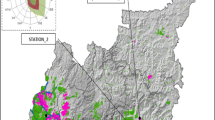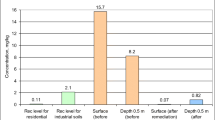Abstract
Five priority areas of potential impact by contaminants (API) were investigated at the Presidente Bernardes Refinery in Cubatão, São Paulo, Brazil with the following aims: (i) to identify both organic and inorganic contaminants present in soil and groundwater; (ii) to define the environmental conditions relevant for microbial activity at the site and (iii) to evaluate the feasibility of employing natural attenuation for treatment of the hydrocarbon contamination. One area (API 1) was an uncontrolled landfill, where waste materials from the refinery were deposited between 1954 and 1986, and four areas (API 4, 5, 7 and 11) were located in the operational section of the refinery. Soil contamination by regulated BTEX compounds (benzene, toluene, total xylenes) was restricted to two samples from API 1. Nonregulated ethylbenzene was detected in one soil sample from API 4, one from API 5 and two from API 1. No soil contained regulated PAH above threshold levels. Several nonregulated PAHs were found in 6 soil samples from API 1, 3 soil samples from API 4 and 1 soil sample from API 5. Site soils contained very high aluminium concentrations, but metal contamination was restricted to one soil sample from API 1, which contained nickel above threshold limits. BTEX contamination of groundwater was due mostly to benzene. Of the 17 PAH molecules tested, only naphthalene and 2-methylnaphthalene occurred in groundwater. The sum of total BTEX and total PAH exceeded 200 μg/L in only a few monitoring wells in API 4, 5 and 11 and was always below 2.640 μg/L. Be, Cd, Cr, Cu, Hg, Ni, Se, Ag, Tl and Zn were not detected in groundwater, which was contaminated in a few locations by aluminium (mostly below 1 mg/L), lead (<0.066 mg/L) and arsenic (<0.056 mg/L). S, K, Ca, Mg and Fe were present in groundwater in excess of physiological requirements for microbial growth, but low concentrations of N and P could become growth limiting. However, BTEX were efficiently degraded in saturated and unsaturated zone microcosms and nutrient amendments did not stimulate biodegradation rates measurably. The inorganic carbon pool in groundwater was up to one order of magnitude larger than the organic carbon pool. Total inorganic carbon (TIC) in API groundwater exceeded TIC of clean groundwater by factors of 2 (API 4), 6 (API 5, 7 and 11) or 10 (API 1). Most of the inorganic carbon incorporated into groundwater beneath the refinery originated from biodegradation in the unsaturated soil, which contained a microbiota (106 cells/g on average) capable of growth with most of the pure (benzene, toluene, ethylbenzene and xylene) and mixed hydrocarbons tested (diesel oil, gasoline, naphtha, condensate, aromatic residue and fuel oil). A viscous hydrocarbon paste uncovered in API 1 was insoluble in water but dissolved in dichloromethane. Many organic components of this paste were biodegradable as evidenced by weight reduction of the hydrocarbon paste and by the growth of suspended and attached biomass in saturated zone microcosms, where the paste was the only carbon source. This study indicates that monitored natural attenuation may be a technically feasible and efficient means for plume control in API 1, 4 and 5, provided the plumes in API 4 and 5 are not expanding. This technique is not suitable for contaminant reduction in API 11.
Similar content being viewed by others
References
Althoff, K., Mundt, M., Eisentraeger, A., Dott, W. and Hollender, J.: 2001, ‘Microcosm experiments to assess the potential for natural attenuation of contaminated groundwater’, Wat. Res 35, 720–728.
Bhupathiraju, V. K., Krauter, P., Holman, H.-Y. N., Conrad, M. E., Daley, P. F., Templeton, A. S., Hunt, J. R., Hernandez, M. and Alvarez-Cohen, L.: 2002, ‘Assessment of in situ bioremediation at a refinery waste-contaminated site and an aviation gasoline contaminated site’, Biodegradation 13, 79–90.
Brady, P. V., Brady, M. V. and Bjorns, D.: 1998, Natural Attenuation CERCLA, RBCA's and the Future of Environmental Remediation, Lewis Publishers, New York.
Conrad, M. E., Templeton, A. S., Daley, P. F. and Cohen, L. A.: 1999, ‘Seasonally-induced fluctuations in microbial production and consumption of methane during bioremediation of aged subsurface refinery contamination’, Environ. Sci. Technol. 33, 4061–4068.
Cornelissen, G., Rigterink, H., Ferdinandy, M. M. A. and Van Noort, P. C. M.: 1998, ‘Rapidly desorbing fractions of PAHs in contaminated sediments as a predictor of the extent of bioremediation’, Environ. Sci. Technol. 32, 966–970.
Dasch, J. M., Abdul, A. S., Rai, D. N., Gibson, T. L. and Grosvenor, N.: 1997, ‘Synergistic application of four remedial techniques at an industrial site’, Groundwater Monitoring Rev. 17(3), 194–209.
Duetz, W. A., Marqués, S., Wind, B., Ramos, J. L. and van Andel, J. G.: 1996, ‘Catabolite repression of the toluene degradation pathway in Pseudomonas putida harboring pWW0 under various conditions of nutrient limitation in chemostat culture’, Appl. Env. Microbiol. 62, 601–606.
Gibson, D. T. and Subramanian, V.: 1984, in: Gibson, D. T. (ed) Microbial Degradation of Organic Hydrocarbons, pp. 181–252, Marcel Dekker, New York.
Heider, J., Spormann, A. M., Beller, H. R. and Widdel, F.: 1998, ‘Anaerobic bacterial metabolism of hydrocarbons’, FEMS Microbiol. Rev. 22(5), 459–473.
Holliger, C., Gaspard, S., Glod, G., Heijman, C., Schumacher, W., Schwarzenbach, R. P. and Vazquez, F.: 1997, ‘Contaminated environments in the subsurface and bioremediation: Organic contaminants’, FEMS Microbiol. Rev. 20(3–4), 517–523.
Iturbe, R., Flores, R. M., Flores, C. M. and Torres, L. G.: 2004, ‘TPH-contaminated Mexican refinery soil: Health risk assessment and the first year of changes’, Env. Monitoring Assessment 91, 237–255.
Juteau, P., Bisaillon, J.-G., Lépine, F., Ratheau, V., Beaudet, R. and Villemur, R.: 2003, ‘Improving the biotreatment of hydrocarbons-contaminated soils by addition of activated sludge taken from wastewater treatment facilities of an oil refinery’, Biodegradation 14, 31–40.
Kraemer, S. M.: 2004, ‘Iron oxide dissolution and solubility in the presence of siderophores’, Aquat. Sci. 66, 3–18.
Kühl, M. and Jørgensen, B. B.: 1992, ‘Microsensor measurements of sulfate reduction and sulfide oxidation in compact microbial communities of aerobic biofilms’, Appl. Env. Microbiol. 58, 1164–1174.
Schäfer, W.: 2001, ‘Predicting natural attenuation of xylene in groundwater using a numerical model’, J. Contam. Hydrol 52, 57–83.
Schmitt, J. and Flemming, H.-C.: 1999, ‘Water binding in biofilms’, Wat. Sci. Tech. 39, 77–82.
Stein, C., Elster, J., Heine, I., Sachse, J. and Peper, H.: 1998, ‘Removal of ammonium nitrogen and hydrogen sulfide from oil refinery wastewater’, Oil Gas-European Magazine 24, 36–39.
Tortora, G. J., Funke, B. R. and Case, C. L.: 1997, Microbiology — An Introduction, Addison Wesley Longman Inc., New York.
Van der Sloot, H. A.: 2002, ‘Characterization of the leaching behaviour of concrete mortars and of cement-stabilized wastes with different waste loading for long term environmental assessment’, Waste Manage. 22, 181–186.
Zarda, B., Mattison, G., Hess, A., Hahn, D., Höhener, P. and Zeyer, J.: 1998, ‘Analysis of bacterial and protozoan communities in an aquifer contaminated with monoaromatic hydrocarbons’, FEMS Microbiol. Ecol. 27, 141–152.
Author information
Authors and Affiliations
Corresponding author
Rights and permissions
About this article
Cite this article
Schneider, R.P., Morano, S.C., Gigena, M.A.C. et al. Contamination Levels and Preliminary Assessment of the Technical Feasibility of Employing Natural Attenuation in 5 Priority Areas of Presidente Bernardes Refinery in Cubatão, São Paulo, Brazil. Environ Monit Assess 116, 21–52 (2006). https://doi.org/10.1007/s10661-006-7243-z
Received:
Accepted:
Issue Date:
DOI: https://doi.org/10.1007/s10661-006-7243-z




